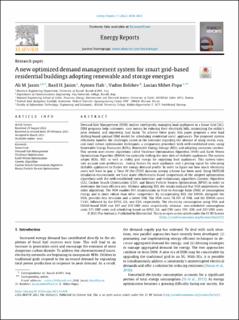| dc.description.abstract | Demand Side Management (DSM) implies intelligently managing load appliances in a Smart Grid (SG). DSM programs help customers save money by reducing their electricity bills, minimizing the utility’s peak demand, and improving load factor. To achieve these goals, this paper proposes a new load shifting-based optimal DSM model for scheduling residential users’ appliances. The proposed system effectively handles the challenges raised in the literature regarding the absence of using recent, easy, and more robust optimization techniques, a comparison procedure with well-established ones, using Renewable Energy Resources (RERs), Renewable Energy Storage (RES), and adopting consumer comfort. This system uses recent algorithms called Virulence Optimization Algorithm (VOA) and Earth Worm Optimization Algorithm (EWOA) for optimally shifting the time slots of shiftable appliances. The system adopts RERs, RES, as well as utility grid energy for supplying load appliances. This system takes into account user preferences, timing factors for each appliance, and a pricing signal for relocating shiftable appliances to flatten the energy demand profile. In order to figure out how much electricity users will have to pay, a Time Of Use (TOU) dynamic pricing scheme has been used. Using MATLAB simulation environment, we have made effectiveness-based comparisons of the adopted optimization algorithms with the well-established meta-heuristics and evolutionary algorithms (Genetic Algorithm (GA), Cuckoo Search Optimization (CSO), and Binary Particle Swarm Optimization (BPSO) in order to determine the most efficient one. Without adopting RES, the results indicate that VOA outperforms the other algorithms. The VOA enables 59% minimization in Peak-to-Average Ratio (PAR) of consumption energy and is more robust than other competitors. By incorporating RES, the EWOA, alongside the VOA, provides less deviation and a lower PAR. The VOA saves 76.19% of PAR, and the EWOA saves 73.8%, followed by the BPSO, GA, and CSO, respectively. The electricity consumption using VOA and EWOA-based DSM cost 217 and 210 USD cents, respectively, whereas non-scheduled consumption costs 273 USD cents and scheduling based on BPSO, GA, and CSO costs 219, 220, and 222 USD cents. | en_US |

